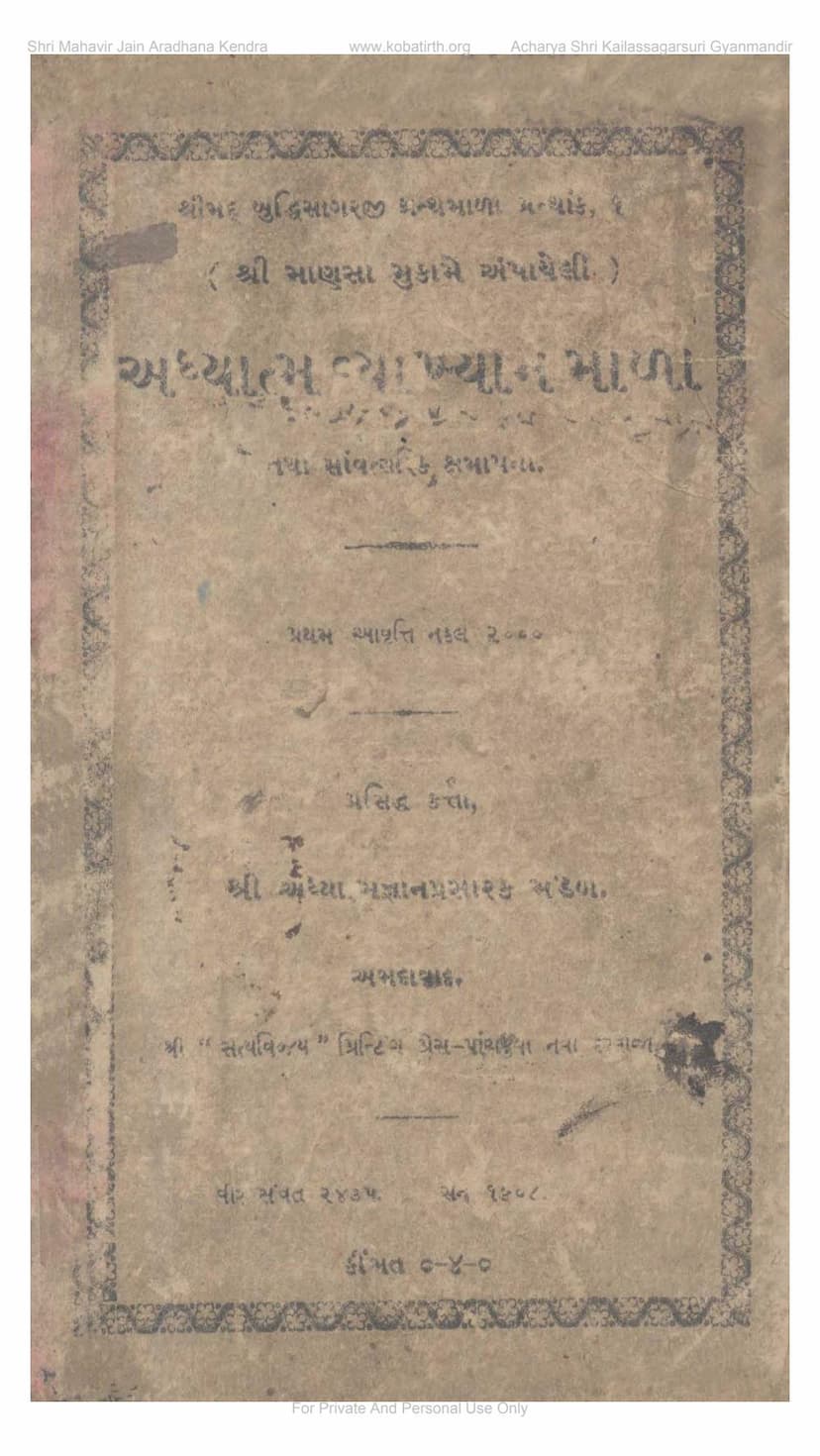Adhyatma Vyakhyanmala
Added to library: September 1, 2025

Summary
This is a comprehensive summary of the Jain text "Adhyatma Vyakhyanmala" by Buddhisagar, published by Adhyatma Gyan Prasarak Mandal. The text is a collection of discourses on spiritual and philosophical topics within the Jain tradition, primarily focusing on the path of self-realization and liberation (moksha).
Here's a breakdown of the key themes and content:
Core Message:
The central theme revolves around Adhyatma, which refers to the spiritual pursuit of understanding and experiencing the true nature of the soul (Atma). The book emphasizes that true happiness and liberation are not found in external worldly pursuits but within the soul itself. It advocates for introspection, self-discipline, and the cultivation of virtues to overcome karmic bondage and attain the state of liberation.
Key Concepts and Teachings:
- The Nature of the Soul (Atma): The text delves into the inherent qualities of the soul, describing it as eternal, pure, conscious, and full of infinite knowledge, perception, bliss, and power. It highlights that this true nature is obscured by ignorance and karmic impurities.
- The Path to Liberation (Moksha): The book outlines the Jain path to liberation, which involves the practice of the Three Jewels (Ratnatraya):
- Samyak Darshan (Right Faith/Perception): Correct understanding of Jain principles and the nature of reality.
- Samyak Gyan (Right Knowledge): Accurate knowledge of the soul and the universe, as expounded by the Tirthankaras.
- Samyak Charitra (Right Conduct): Ethical living, adherence to vows, and self-discipline.
- Overcoming Karma: A significant portion of the text focuses on understanding the nature of karma, its influx (ashrava), its bondage (bandha), its fruition (udaya), and the means to prevent further influx and shed existing karma (samvara and nirjara).
- The Importance of the Guru: The text consistently stresses the indispensability of a spiritual teacher (Guru) in guiding the seeker on the path of Adhyatma. The Guru's guidance, teachings, and example are considered crucial for dispelling ignorance and attaining true spiritual knowledge.
- Practices for Spiritual Growth: Various practices are discussed, including:
- Meditation and Contemplation (Dhyana): Focusing the mind on the soul's true nature.
- Austerities (Tapa): Self-discipline and purification through various forms of penance.
- Ethical Living: Adherence to principles of non-violence (ahimsa), truthfulness (satya), non-stealing (asteya), celibacy (brahmacharya), and non-possession (aparigraha).
- Vow Observance: The importance of observing religious vows for spiritual progress.
- Mind Control: The necessity of mastering the mind and senses to prevent them from wandering into worldly distractions.
- Introspection: Regular self-examination to identify and eradicate internal impurities like anger, pride, deceit, and greed.
- The Nature of the World: The text often contrasts the ephemeral and ultimately unsatisfactory nature of worldly pleasures and possessions with the eternal and blissful nature of the soul. It encourages detachment from the material world.
- The Role of the Community (Sangh): The text mentions the gathering at Manasa, where devotees from various places came together for spiritual discourse and practice. This highlights the importance of communal spiritual support and learning.
- The Teachings of the Tirthankaras: The discourses are rooted in the teachings of Lord Mahavir Swami and other Tirthankaras, emphasizing the authenticity and validity of their doctrines.
Structure and Content Highlights:
- Mangalacharan: The book begins with auspicious invocations, paying homage to Lord Mahavir and the spiritual lineage.
- Context of Discourses: The introduction explains the genesis of these discourses, held in Manasa under the guidance of Muni Buddhisagarji, with enthusiastic participation from the Jain community.
- Detailed Discourses: The core of the book consists of the verbatim transcription of the discourses delivered on various days, covering topics like:
- The difference between worldly knowledge and spiritual knowledge.
- The nature of Adhyatma and Yoga.
- The significance of adherence to principles and conduct.
- The relationship between the soul and material substances.
- The importance of a balanced approach between ultimate truth (nishchaya naya) and conventional truth (vyavahar naya).
- The role of scientific understanding in proving religious tenets.
- The importance of virtues like compassion, forgiveness, and humility.
- The critique of superficial religious practices without inner spiritual understanding.
- The spiritual journey through different stages of spiritual development (Gunasthanas).
- The concept of the Six-fold Truth (Shat-sthana) in Jainism.
- The nature of Devotion (Bhakti) and its various forms.
- The power of concentration and meditation.
- The ultimate goal of achieving the state of liberation, where the soul is free from all karmic bondage.
- Quotations and Examples: The text frequently incorporates verses from scriptures and quotes from renowned Jain scholars and saints like Hemachandracharya, Yashovijayji, Anandghanji, and others to illustrate spiritual points.
- Emphasis on Practice: While knowledge is important, the text consistently emphasizes the need to translate spiritual understanding into practical living and consistent practice.
- Samvatsarik Kshamaapan (Annual Forgiveness): The text also includes a section on annual forgiveness, a significant Jain ritual, highlighting its importance in spiritual purification and maintaining harmonious relationships.
- Philanthropy: The text mentions the financial support from individuals for the publication of the book, underscoring the importance of contributing to the spread of spiritual knowledge.
Overall Tone and Purpose:
The "Adhyatma Vyakhyanmala" serves as a guide for spiritual seekers within the Jain tradition. It aims to:
- Educate: Provide in-depth knowledge about core Jain philosophical concepts.
- Inspire: Motivate readers to embark on their own spiritual journeys.
- Guide: Offer practical advice and methods for spiritual practice.
- Promote Harmony: Foster a spirit of brotherhood and mutual respect among Jains and beyond.
- Spread Spiritual Awareness: Encourage the widespread dissemination of spiritual knowledge for the welfare of all beings.
The language is rich and philosophical, drawing heavily on classical Jain terminology and concepts, presented in Gujarati with some Sanskrit and other Indian language quotes. The compilation is intended for private and personal use, suggesting a focus on individual spiritual growth and practice.